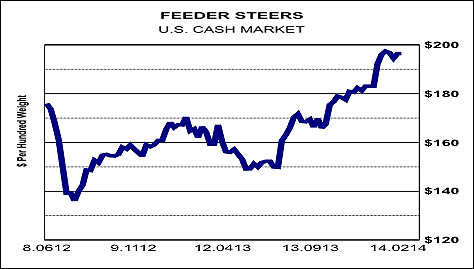One of our greatest fears is being forced, for economic reasons, to consume dry, boneless, skinless, tasteless chicken breasts. Beef is the proper food for people, not the meat of something that when free range raised pecks in the dirt. The source of this worry? The chart below is of the price of beef, boxed and hanging as measured by the USDA. As is readily apparent even to those that consume chicken breasts, the price of beef has reached a record high. Such prices may force us to substitute the meat of a pale flightless bird for our beloved beef. Yuch!
Why have beef prices risen so dramatically? Well, we start with knowing that beef is not made in a factory, but begins in the old-fashioned way. As we are writing for polite company, the story of the bull and the heifer will be skipped.
Due to years of drought in the cattle producing areas of the U.S. and high costs of feed, feeder cattle are in short supply. As a consequence, feeder cattle have been selling at record prices, as shown in the chart below.
Foundation for high beef prices has been built over a number of years, and a turnaround in the situation will take time. Chart below portrays U.S. cattle inventory over recent years. That cattle herd is now the smallest since 1951. At same time due to drought and lack of serious water management in California, the cattle herd of that state is being liquidated. Despite the vast complex of social networking sites, the cow with calf cannot be rushed. Still takes about 9 months for a calf to be born.
While we have focused above on the U.S. beef situation, the global demand for animal proteins is strong. The short grain situation brought on by the weak Fall 2012 North American harvest caused animal feed grains to be both in short supply and of high price until last Fall. Global demand for animal proteins was not satisfied in that intervening year. The world is making up for that hunger.
U.S. corn used as feed will rise to 38% of production this year, and be more important than ethanol to North American corn farmers. U.S. corn exports, most of which will become animal feed, will more than double this crop year. In Canada, due to a combination of factors, bloomberg.com reports that unmet orders for grain rail cars to facilitate exports of canola and other grains to be used for animal feed around the world recently numbered 51,000.
Obvious beneficiaries of this situation are U.S. beef producers, as well as those in Brazil and Australia. Corn, soybean, and canola producers will benefit
from strong export demand for animal feed. As strong, global demand for animal proteins is now part of permanent ongoing and repetitive total demand for Agri-Foods, prices for these grains should rise over time. Another group that should gain financially from this situation are hog and broiler producers. The beef situation creates a price umbrella for pork and chicken producers. As a hungry world grills its meat, Agri-Equities will profit.









